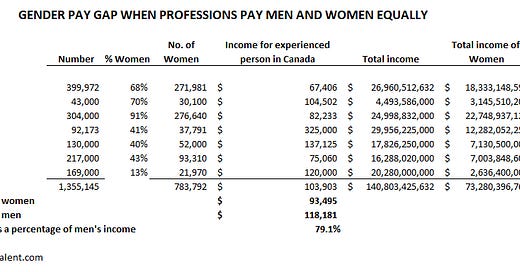The highest paying jobs for university graduates in today’s society comprise careers that flow from studies concentrated in Science, Technology, Engineering and Mathematics (STEM). The 25 highest paying jobs for university graduates are all jobs that require a STEM based degree.
Both men and women are are free to enrol in STEM programs in university, but the percentage of women who study STEM courses or apply to study engineering in university is less than that of men:
In the United Kingdom in 2019, 19% of students taking core STEM courses were women and 23.5% of engineering graduates were women. 94% of women believe science and engineering are suitable careers for either gender. So why the disparity? The answer is preferences. While virtually all women believe science and engineering are suitable careers for women, the vast majority of women don’t enrol in those fields.
In the United States, 36% of STEM graduates in 2018 were women.
In Canada, fewer women than men enrol in STEM courses in univerity and more of them leave those STEM programs to graduate in non-STEM programs in the humanities, arts, health, social science and education.
If women prefer education in areas that do not command as much pay as men, there will be a difference in their average incomes that result from their choices. Woke Liberals point to the 11% difference in average incomes of women and men in Canada as evidence of a “tyrannical patriarchy” and activists have formed organization whose objective is to narrow or close the “pay gap”. The facts don’t support the feminist rhetoric. If women want to earn more money they need to enter higher paying fields of work, something they are not prevented from doing by any “tyrranical patriarchy” or other barrier.
But the evidence is overwhelming that women prefer lines of work that align with their chosen studies in humanities, arts, health, social science and education.
In Canada, 68% of Canada’s 399,972 teachers are women
In Canada, 91% of 304,000 nurses are women
In Canada, 60 to 70% of Canada’s 43,000 pharmacists are women
In higher paying professions like law, accountancy, engineering and medicine
About 40% of Canada’s 130,000 lawyers are women
About 43% of Canada’s 217,000 accountants are women, although 50% of persons entering the field are women
About 13% of Canada’s 169,000 engineers are women
About 40% of Canada’s physicians are women
The vocations listed above employ 1.1 million Canadians over half of whom are women. Within each profession, there are debates over whether men get paid more than women in each case, and the “pay gap” is referenced as the foundation for the argument that women suffer prejudice. But would that “pay gap” disappear if men and women received precisely the same compensation in each profession?
The answer is “not by a long shot”. The explanation is that men and women make different choices within that menu of professions. Based on the best data I could find, here is the outcome. In Canada today, a higher proportion of women choose careers as teachers, pharmacists, and nurses and a lower proportion as physicians, lawyers, accountants or engineers. Those proportions are changing as more women are entering the higher paying fields, but the data are reasonably current as of today.
The table assumes each person in each profession receives the same compensation, and the compensation levels chosen from data available from Talent.com are for experienced workers in each profession - in other words, the career opportunity as opposed to the average salary or starting salary. The table makes it clear - the pay gap exists since the result is that (under the assumptions of the analysis) women on average earn 79% of the income enjoyed by men despite both women and men being paid at the same rate in each profession. How is that possible? Simply because women tend to choose professions that pay less than those chosen by men.
The analysis is limited to the seven professions listed and shows a wider “pay gap” than estimated by Statistics Canada of 11% referenced earlier, but is valuable in that it points out the reality that it is choice rather than prejudice that returns a “gender pay gap”. That outcome is consistent with the largest and most recent study of differences in gender pay involving 80,000 people in a number of countries compared by Gini Coefficient - the best available measure of equality of opportunity. That study found that countries with the least disparity in opportunity across genders had the highest “gender pay gap”.
Instead of the incessant feminist claims of a patriarchal tyrrany suppressing opportunities for women, the Liberal left might advise women to pursue careers that meet their preferences for income and lifestyle and provide them accurate information on the economic impact of their choices. For those who aspire to higher income, the opportunities are not foreclosed to men or women but are readily available to either for those who wish to to pursue them, and come with lifestyle implications they must embrace to be successful therein.
It is time for Liberal leaders to stop promoting nonsense that is divisive, destructive and inaccurate.



